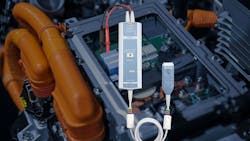High-Voltage, Wide-Bandwidth Probe Tests the Limits of Power Electronics
A new high-voltage, wide-bandwidth probe gives engineers the ability to more accurately test the high-speed switching signals generated by the power electronics in electric vehicles (EVs) and renewable-energy gear.
Yokogawa Test and Measurement launched its latest family of differential probes that feature a maximum input voltage of 2,000 V and frequency bandwidth of up to 400 MHz. To measure everything from the characteristics of power transistors to ringing and other fluctuations that can occur during switching, the oscilloscope and the probe paired with it must have higher bandwidth. Thanks to that, power engineers can capture more intricate signals, which is important for improving a power supply’s overall efficiency.
The pursuit of efficiency is particularly acute in the power electronics industry. Power devices based on silicon carbide (SiC) and gallium nitride (GaN) are overtaking silicon in everything from EV traction inverters to power-supply units (PSUs) in data centers. These devices can handle larger amounts of power more efficiently due to their faster switching speeds. However, testing and evaluating them requires ultra-precise measurement of high-voltage, high-speed signals, said Yokogawa.
To accurately measure these rapidly changing voltages, engineers need to measure the voltage difference between different parts of a circuit. They must be able to perform measurements even when neither of these points are connected to ground, meaning they’re at a "floating" or "ungrounded" potential. Standard practice is to use a high-bandwidth oscilloscope paired with a differential probe such as Yokogawa’s new PBDH0400 series.
To stay a step ahead of the latest trends in power conversion, Yokogawa noted that the PBDH0400 series can measure high voltages across a wide frequency range of up to 400 MHz. This is valuable for testing traction inverters in EVs and other next-gen power electronics, as it enables the accurate observation of tiny changes in high-speed switching signals. Improvements were also made to noise rejection, enabling the detection of events that can cause anomalies in the signal’s waveform, including overshoot and ringing.
The PBDH0400 can be used for power analysis of IGBTs and more advanced SiC, GaN, and other power switching devices, as well as precise evaluation of the high-speed, high-voltage switching signals generated by these devices. Yokogawa said the series of probes is also ideal for the analysis and testing of electric motors and other industrial power systems, even those used in household appliances and air conditioners.
The Point of the Probe in Testing and Measuring Power Electronics
Understanding the operation of a DC-DC converter, inverter, or any other power supply under both the best and worst conditions is vital. The load placed on the system can change dramatically from one instant to the next, and in many cases, the power electronics must be able to withstand sudden peak loads that surpass the average operating levels. On top of that, different environmental conditions can disrupt the power supply’s performance.
The oscilloscope is widely used by power electronics engineers because it can perform measurements in both the time and frequency domains—and correlate them for the purposes of power analysis and testing. For instance, if you increase the switching speed of the power supply by upgrading to a SiC MOSFET, you can measure the turn-on and turn-off behavior of the transistor in the time domain and evaluate the impact on electromagnetic interference (EMI) in the frequency domain.
>>Check out this Series Library for similar articles and videos
In EVs, a traction inverter is used to convert DC from the lithium-ion (Li-ion) battery pack to the three-phase AC that drives the electric motor. One of the principal challenges for engineers today is reduction of switching losses during this power conversion. To check the switching loss, it’s important for engineers to understand the transition time with the voltage and current waveforms when the MOSFET or other power switch at the heart of the inverter turns on and off.
But the transition time between off and on is significantly faster for power transistors based on SiC than silicon IGBTs. As a result, the oscilloscope used to measure switching loss needs to have higher bandwidth. For context, a bandwidth of 350 MHz or more is required to keep up with rise times as fast as 1 ns, said Yokogawa.
In addition to the high bandwidth of the oscilloscope or other test equipment measuring the switching waveform of the power switch, test and measurement companies are upgrading the probes paired with the oscilloscopes to have better bandwidth and noise rejection. One such company, Tektronix, recently rolled out a new family of galvanically isolated oscilloscope probes to more accurately measure fast-changing currents in low- and high-voltage systems based on SiC and GaN.
Yokogawa highlighted the traction inverter that drives the three-phase motor in the EV. In this scenario, the gate-to-source voltage (Vgs) on the high side is the switching command. To evaluate the high-speed, high-voltage switching signals exhibited by the SiC or other power device, the engineer must be able to observe the voltage waveform. One of the problems in this situation is that the signal isn’t ground referenced. Due to this floating potential, a high-voltage differential probe must be used to monitor the Vgs.
However, any fluctuations in the floating potential can affect how accurately the oscilloscope can measure the signal, preventing correct observation of the voltage waveform. In general, the higher the frequency, the worse the problem becomes, said Yokogawa. Therefore, it’s necessary to use differential probes that are less susceptible to fluctuations in the floating potential, namely by offering a higher common-mode rejection ratio (CMRR).
How High-Bandwidth Probes Handle the Switching Speeds of SiC
According to Yokogawa, the PBDH0400 family has the high bandwidth required to keep up with the faster switching frequencies of SiC and other next-gen power electronics. And it can handle rise times of under 1 ns.
In addition, the company said it features superior noise rejection and frequency-response flatness characteristics, giving engineers the ability to capture signals more clearly from the power device and accurately identify any anomalies in the waveform of the signal. When paired with one of its oscilloscopes, the probes can support CMRR of −50 dB at 10 MHz, −30 dB at 100 MHz, and −20 dB at a maximum bandwidth of 400 MHz.
To capture the fast-changing high-voltage signals in power electronics, the probes can handle attenuation ratios—which reduce the power of the signal without distorting its waveform—of 500:1/50:1 or 1,000:1/100:1. Furthermore, engineers can toggle the switch on the side of the probe to select and then configure the attenuation ratio of the probe along with the input impedance. It’s not unusual for power engineers to inadvertently introduce errors during the manual setting process, said Yokogawa.
Featuring a “pincher tip,” the new family also features automatic power-supply and attenuation settings. The PBDH0400 is based on the company’s proprietary probe interface, saving both cost and space by eliminating the need for a separate power supply when connected to a Yokogawa oscilloscope. The attenuation ratio is automatically set through the interface, too, so it can start measuring signals immediately after connecting. The tradeoff with the proprietary interface is that the probes must be paired with Yokogawa’s oscilloscopes.
The company rolled out several different differential probes as part of the PBDH0400 family: The 702922 model features a maximum input voltage of 2,000 V, while the 702921 model can support up to 1,000 V.
>>Check out this Series Library for similar articles and videos
About the Author
James Morra
Senior Editor
James Morra is the senior editor for Electronic Design, covering the semiconductor industry and new technology trends, with a focus on power electronics and power management. He also reports on the business behind electrical engineering, including the electronics supply chain. He joined Electronic Design in 2015 and is based in Chicago, Illinois.


